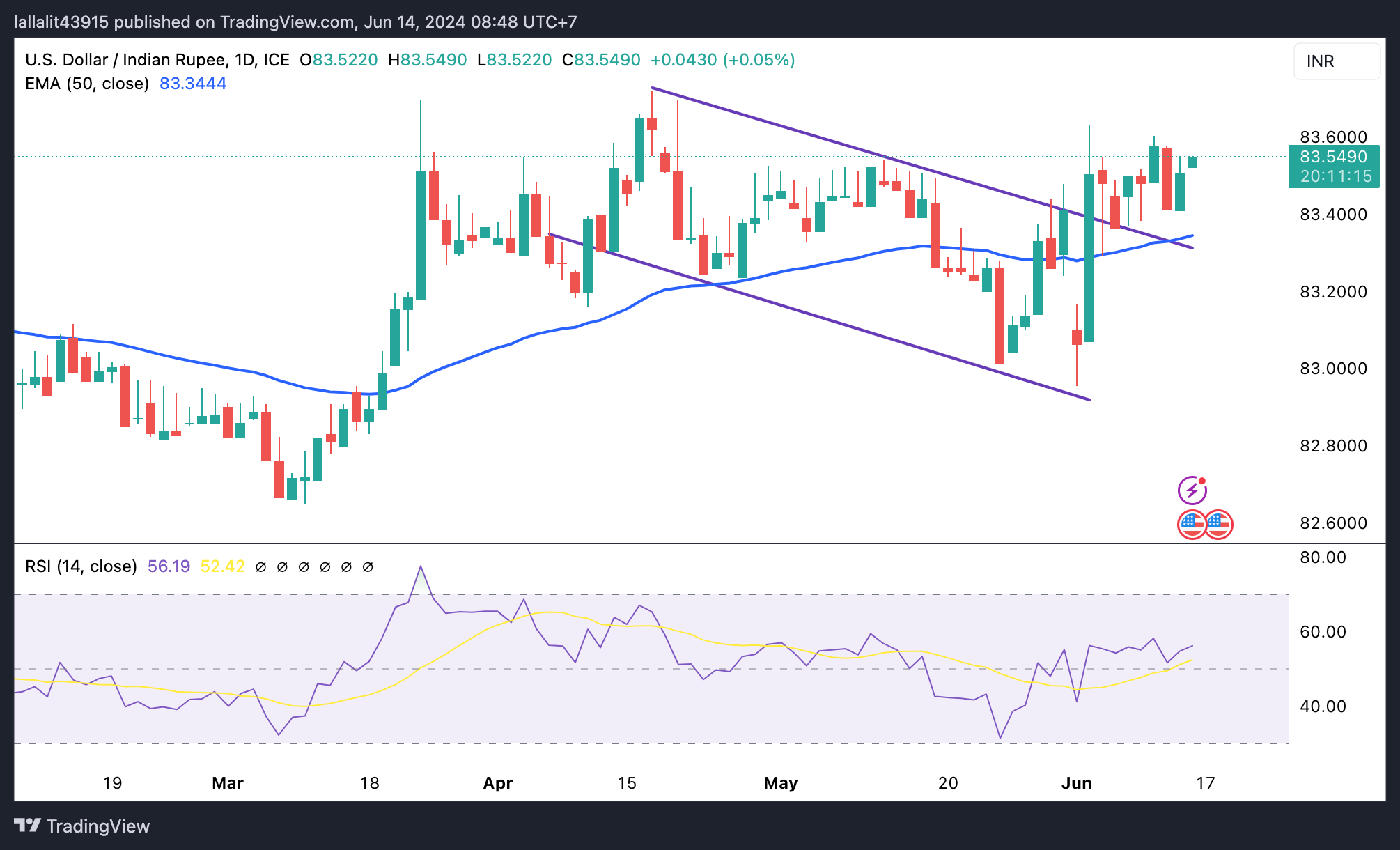- Indian Rupee trades in negative territory on Friday amid the stronger US Dollar.
- The Indian WPI Inflation came in hotter than expected, rising 2.61% YoY in May from 1.26% in April.
- The hawkish Fed projection suggested only one rate cut is likely in 2024, weighing the INR.
- Investors await the preliminary US Michigan Consumer Sentiment report, which is due on Friday.
Indian Rupee (INR) weakens on Friday on the extended gains of US Dollar (USD). The INR remains under some selling pressure despite the hotter-than-expected Indian inflation data. The recent economic data showed that India’s Wholesale Price Index (WPI) Inflation rose 2.61% YoY in May from 1.26% in the previous reading, above the market consensus of 2.50%.
The projections that the US Federal Reserve (Fed) will cut rates only once by 25 basis points (bps) this year instead of the two that the consensus had expected weighs on the INR. Additionally, the higher crude oil prices could further cap the upside for the local currency as India is the third largest consumer of oil behind the US and China.
Nonetheless, the Reserve Bank of India’s (RBI) intervention will be crucial in stabilizing the INR and preventing it from significant depreciation. Later on Friday, investors will keep an eye on the US preliminary Michigan Consumer Sentiment report and the speech by the Fed Bank of Chicago President Austan Goolsbee.
Daily Digest Market Movers: Indian Rupee edges lower amid the Fed’s hawkish stance
- India’s WPI Food climbed 9.82% YoY in May, compared to 7.74% in April. Meanwhile, the WPI Fuel increased by 1.35% in the same period, compared to 1.35% in April.
- State-run banks were spotted offering USD through the day's session, likely on behalf of the RBI, but they "were holding the level" instead of pushing the INR towards appreciation, a foreign exchange trader at a private bank said.
- The benchmark S&P BSE Sensex ended the session up 204.33 points, or 0.27%, at 76,810.90, while the NSE Nifty index closed at 23,398.90, up 75.95 points, or 0.33% from its previous close.
- The US Producer Price Index (PPI) rose 2.2% YoY in May, compared to the 2.3% increase in April (revised from 2.2%), below the market expectation of 2.5%. The core PPI figure climbed 2.3% YoY in May, below the estimation and previous reading of 2.4%.
- On a monthly basis, the US PPI declined 0.2% in May, while the core PPI remained unchanged at 0%.
- The US weekly Initial Jobless Claims for the week ending June 6 increased by 242K from the previous week's reading of 229K. This figure came in above the market consensus of 225K.
- Fed Chair Jerome Powell said that only "modest" progress had been achieved towards meeting the target and that the US central bank would need "good inflation readings" before cutting interest rates, per the BBC.
Technical analysis: USD/INR maintains its uptrend in the longer term
The Indian Rupee trades on a softer note on the day. The USD/INR pair has been making higher highs and higher lows since the start of June while holding above the key 100-day Exponential Moving Average (EMA) and descending trend channel upper boundary on the daily timeframe. This indicates that the path of least resistance is to the upside. The 14-day Relative Strength Index (RSI) remains in the bullish zone around 55.50, supporting the buyers for the time being.
If the pair continues to see bullish demand, the first upside barrier will emerge at 83.60, a high of June 11. Then, USD/INR may extend its upswing to 83.72, a high of April 17. Further north, the additional upside filter to watch is the 84.00 round mark.
The crucial support level for the pair is seen in the 83.30–83.35 zone, portraying the confluence of the 100-day EMA and descending trend channel upper boundary. A break below this level could see a drop to the 83.00 psychological level, followed by 82.78, a low of January 15.
US Dollar price in the last 7 days
The table below shows the percentage change of US Dollar (USD) against listed major currencies in the last 7 days. US Dollar was the strongest against the Euro.
| USD | EUR | GBP | CAD | AUD | JPY | NZD | CHF | |
| USD | 1.61% | 0.43% | 0.58% | 0.69% | 1.30% | 0.86% | 0.45% | |
| EUR | -1.63% | -1.15% | -1.04% | -0.92% | -0.23% | -0.74% | -1.16% | |
| GBP | -0.48% | 1.13% | 0.11% | 0.21% | 0.85% | 0.39% | -0.03% | |
| CAD | -0.57% | 1.03% | -0.13% | 0.12% | 0.75% | 0.30% | -0.13% | |
| AUD | -0.71% | 0.90% | -0.24% | -0.12% | 0.69% | 0.18% | -0.24% | |
| JPY | -1.36% | 0.20% | -0.94% | -0.85% | -0.72% | -0.54% | -0.93% | |
| NZD | -0.87% | 0.73% | -0.42% | -0.29% | -0.17% | 0.50% | -0.42% | |
| CHF | -0.43% | 1.14% | 0.00% | 0.13% | 0.24% | 0.92% | 0.41% |
The heat map shows percentage changes of major currencies against each other. The base currency is picked from the left column, while the quote currency is picked from the top row. For example, if you pick the Euro from the left column and move along the horizontal line to the Japanese Yen, the percentage change displayed in the box will represent EUR (base)/JPY (quote).
Indian Rupee FAQs
The Indian Rupee (INR) is one of the most sensitive currencies to external factors. The price of Crude Oil (the country is highly dependent on imported Oil), the value of the US Dollar – most trade is conducted in USD – and the level of foreign investment, are all influential. Direct intervention by the Reserve Bank of India (RBI) in FX markets to keep the exchange rate stable, as well as the level of interest rates set by the RBI, are further major influencing factors on the Rupee.
The Reserve Bank of India (RBI) actively intervenes in forex markets to maintain a stable exchange rate, to help facilitate trade. In addition, the RBI tries to maintain the inflation rate at its 4% target by adjusting interest rates. Higher interest rates usually strengthen the Rupee. This is due to the role of the ‘carry trade’ in which investors borrow in countries with lower interest rates so as to place their money in countries’ offering relatively higher interest rates and profit from the difference.
Macroeconomic factors that influence the value of the Rupee include inflation, interest rates, the economic growth rate (GDP), the balance of trade, and inflows from foreign investment. A higher growth rate can lead to more overseas investment, pushing up demand for the Rupee. A less negative balance of trade will eventually lead to a stronger Rupee. Higher interest rates, especially real rates (interest rates less inflation) are also positive for the Rupee. A risk-on environment can lead to greater inflows of Foreign Direct and Indirect Investment (FDI and FII), which also benefit the Rupee.
Higher inflation, particularly, if it is comparatively higher than India’s peers, is generally negative for the currency as it reflects devaluation through oversupply. Inflation also increases the cost of exports, leading to more Rupees being sold to purchase foreign imports, which is Rupee-negative. At the same time, higher inflation usually leads to the Reserve Bank of India (RBI) raising interest rates and this can be positive for the Rupee, due to increased demand from international investors. The opposite effect is true of lower inflation.
Information on these pages contains forward-looking statements that involve risks and uncertainties. Markets and instruments profiled on this page are for informational purposes only and should not in any way come across as a recommendation to buy or sell in these assets. You should do your own thorough research before making any investment decisions. FXStreet does not in any way guarantee that this information is free from mistakes, errors, or material misstatements. It also does not guarantee that this information is of a timely nature. Investing in Open Markets involves a great deal of risk, including the loss of all or a portion of your investment, as well as emotional distress. All risks, losses and costs associated with investing, including total loss of principal, are your responsibility. The views and opinions expressed in this article are those of the authors and do not necessarily reflect the official policy or position of FXStreet nor its advertisers. The author will not be held responsible for information that is found at the end of links posted on this page.
If not otherwise explicitly mentioned in the body of the article, at the time of writing, the author has no position in any stock mentioned in this article and no business relationship with any company mentioned. The author has not received compensation for writing this article, other than from FXStreet.
FXStreet and the author do not provide personalized recommendations. The author makes no representations as to the accuracy, completeness, or suitability of this information. FXStreet and the author will not be liable for any errors, omissions or any losses, injuries or damages arising from this information and its display or use. Errors and omissions excepted.
The author and FXStreet are not registered investment advisors and nothing in this article is intended to be investment advice.
Recommended content
Editors’ Picks

AUD/USD holds higher ground above 0.6000 despite US-Sino trade war
AUD/USD hold the rebound above 0.6000 in the Asian session on Tuesday, helped by a recovery in risk sentiment on China's support measures to stabilize markets. A renewed US Dollar selling also aids the Aussie's upswing but further upside appears elusive amid escalating US-China trade war.

USD/JPY stalls its recovery from multi-month low; remains below 148.00
USD/JPY oscillates around the 148.00 mark during the Asian session on Tuesday amid mixed cues. A modest recovery in the global risk sentiment, along with receding bets that the BoJ would raise the policy rate at a faster pace, undermines the safe-haven JPY.

Gold price moves away from multi-week low; looks to reclaim $3,000
Gold price edges higher during the Asian session on Tuesday and now seems to have snapped a three-day losing streak to a nearly four-week low touched the previous day. Concerns that a trade war will hit the US economy and trigger a recession, along with mounting bets for more aggressive rate cuts by the Fed, cap the USD recovery.

Trump tariffs shake crypto markets, where are Bitcoin and meme coins headed?
Bitcoin and altcoin prices were on a rollercoaster ride on Monday as traders digested the developments surrounding tariffs. From speculation of a 90-day pause on tariffs to Bitcoin’s price swinging from a $74,500 low to $81,200 high within a single day, the crypto market meltdown has been an event for traders.

Strategic implications of “Liberation Day”
Liberation Day in the United States came with extremely protectionist and inward-looking tariff policy aimed at just about all U.S. trading partners. In this report, we outline some of the more strategic implications of Liberation Day and developments we will be paying close attention to going forward.

The Best brokers to trade EUR/USD
SPONSORED Discover the top brokers for trading EUR/USD in 2025. Our list features brokers with competitive spreads, fast execution, and powerful platforms. Whether you're a beginner or an expert, find the right partner to navigate the dynamic Forex market.




